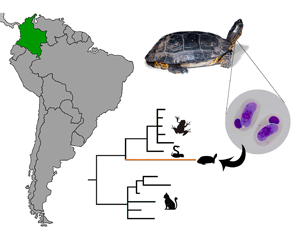Article contents
Molecular and morphological description of the first Hepatozoon (Apicomplexa: Hepatozoidae) species infecting a neotropical turtle, with an approach to its phylogenetic relationships
Published online by Cambridge University Press: 04 February 2021
Abstract

Haemogregarines (Adeleorina) have a high prevalence in turtles. Nevertheless, there is only one Hepatozoon species described that infects Testudines so far; it is Hepatozoon fitzsimonsi which infects the African tortoise Kinixys belliana. Colombia harbours a great diversity of chelonians; however, most of them are threatened. It is important to identify and characterize chelonian haemoparasite infections to improve the clinical assessments, treatments and the conservation and reintroduction programs of these animals. To evaluate such infections for the Colombian wood turtle Rhinoclemmys melanosterna, we analysed blood from 70 individuals. By using the morphological characteristics of blood stages as well as molecular information (18S rRNA sequences), here we report a new Hepatozoon species that represents the first report of a hepatozoid species infecting a semi-aquatic continental turtle in the world. Although the isolated lineage clusters within the phylogenetic clades that have morphological species of parasites already determined, their low nodal support makes their position within each group inconclusive. It is important to identify new molecular markers to improve parasite species identification. In-depth research on blood parasites infecting turtles is essential for increasing knowledge that could assess this potential unknown threat, to inform the conservation of turtles and for increasing the state of knowledge on parasites.
- Type
- Research Article
- Information
- Copyright
- Copyright © The Author(s), 2021. Published by Cambridge University Press
References
- 10
- Cited by





